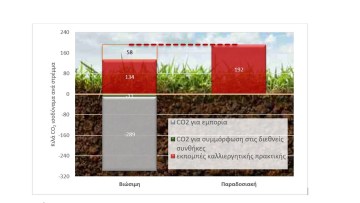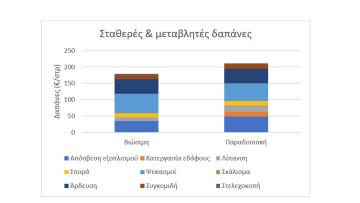Sustainable farming practices- Cotton
09.06.2021
Sustainable cultivation practices for cotton crop
To produce 430 kg of cotton, about 200 kg of CO2 equivalents are released into the atmosphere.
The implementation of sustainable cultivation practices, that save resources, limit the impact on the environment and the atmosphere, and improve agricultural income is the only solution for agriculture. In a recent study, the University of Thessaly in collaboration with BASF, proved that cotton in Greece can be cultivated with alternative, sustainable practices, which use 15% less energy, reduce direct carbon dioxide emissions into the atmosphere by 18% and, at the same time, offer the possibility of storing in the soil up to 80 kilos of carbon per acre, each year.
All the information above, allow the conditions of the European Union to be oversubscribed, which requires the reduction of the greenhouse gas emissions from agriculture by 30% by 2030, and moreover, they leave, a significant margin for improvement of agricultural income, both through the reduction of production costs and the sale of carbon credits.
Carbon emissions in cotton production
The study was carried out in 2020 in two pilot fields in Ryzomilos of Magnesia by the Laboratory of Agricultural Engineering of the University of Thessaly. Through the study it was calculated that, to produce a kilo of cotton took about 2,66 KWh of energy (in the form of fuels, supplies, and materials), which is equivalent to 0,44 kg CO2 equivalents.
CO2 equivalents mean the emissions of all greenhouse gases expressed as equivalent carbon dioxide values for simplification. For a typical crop production of about 430 kilos per acre, about 200 kilos of CO2 equivalents are released into the atmosphere. These emissions can be drastically reduced if we use cultivation techniques that use less energy.
In terms of sources of energy inputs in cotton production, 37% of the total inputs were due to irrigation. Second in size and importance was the consumption of energy through fertilizers (29%). The next two most important areas were plant protection and soil preparation (about 15% of total inputs each). The remaining 5% of energy inputs are for sowing and harvesting. If for all the above energy inputs, we calculate the corresponding greenhouse gas emissions and express them as CO2 equivalents, we can estimate the “carbon footprint” of the crop. In this light, irrigation is responsible for 53% of emissions, followed by soil treatment with 24% and fertilization with 12%.
Conservation Agriculture – A Sustainable Alternative Practice
The sustainable cultivation practice proposed by the University of Thessaly included the application of zero soil treatment in combination with crop rotation with legumes. A pilot field of a farmer was found in which there was a four – year alfalfa crop, which was terminated with the application of a universal herbicide and without any other intervention in the soil, cotton was sown with the special machine for direct sowing. Crop rotation and minimal soil disturbance are two of the three main pillars proposed by the Conservation Agriculture system to ensure the sustainability of agricultural production. The third pillar is the permanent covering of the soil surface with dead plant matter or active vegetation.
As a witness for the evaluation of the new practices, a neighboring pilot filed with cotton crop of the same variety was used, which was cultivated according to the traditional practices of the farmer (plowing, cultivator, pellet cop) and which had as a previous crop of cotton (in 1/3) and wheat in the rest.

One of the first direct benefits of the practice followed, was the saving of energy from the absence of soil work. A second, the saving of nitrogen fertilizers due to crop rotation with legumes. It is estimated that CO2 emissions are reduced by almost 58 kg per acre, i.e., 25%, a significant reduction, but this is not enough to achieve the 30% target set by the EU.
Studies have shown that for Greece, the practice of conservative agriculture can contribute to the incorporation of about 300 kg of CO2 equivalents into the acre per year. If we subtract 11 kilos remaining to meet the EU’s 30% condition, there are another 289 kg left for use in the carbon credit trade.
During the last year, the price of CO2 equivalents in the international market ranged from 20€ to 50€ per ton. With the price of 20€ per ton, for the 289 kg there is a prospect of an extra income for the farmer of 5.8€ per acre.
The cultivation practice of conservative agriculture emits 58kg per acre less CO2 and enables the storage of 300 kg in the soil.

Cost of cotton cultivation
Making an overall assessment of the economic benefits of conservative agriculture, we will see that, in addition to CO2 emissions trading, there are also benefits in other sectors too.
The saving of fuel and labor, the depreciation of mechanical equipment and the reduction of fertilizers’ usage are the main ones.
In the economic analysis of the University, both annual variable costs (labor, supplies, fuel, etc.) and the fixed costs (depreciation of machinery, amortization, contributions, etc.) were evaluated. The second category is the one that is usually overlooked by farmers, since it does not concern expenses of the annual growing season, but expenses made over a long period of time in the form of fixed investments.
These expenses are particularly significant and are what distinguish an economically viable farm from an unsustainable one.
In the case of witness field with the traditional technique, the variable costs were 162€ per acre and the fixed ones 49€ per acre. The gin turn out of cotton was 436 kg per acre in wheat – cotton crop rotation and 405 kg per acre in cotton – cotton crop rotation. With the 436 kg, there remains a profit of 82€ per acre if we count only the variable expenses.
With the 406 kg there remains 64€ per acre. These are the profits that the farmer perceives. However, if we also count the fixed expenses, we will find that the real profit is 33€ per acre for the high yield and only 15€ per acre for the low one. In fact, the profit is very easy to evaporate, if the production falls below 380 kg per acre, making the crop unsustainable.
The profit for the farmer evaporates if the production falls below 380 kg per acre making the cultivation of cotton unsustainable.
Sustainable practices to reduce production costs
Now, let us look at what the system of sustainable farming has achieved. Firstly, direct sowing eliminates the cost of soil preparation, which was 18.6€ per acre. But there was an additional cost pf 5.5€ per acre for the application of a universal herbicide to end alfalfa and control weeds.
Secondly, the cost of fertilizers was reduced by 9.4€ per acre, as alfalfa enriches the soil with nitrogen. Thirdly, fixed costs are reduced by 12.4€ per acre, because in the system of conservative agriculture there are no longer any processing machines, and other tasks (sowing, fertilization, spraying) can be carried out with a smaller agricultural tractor.
There is only one extra cost of about 2€ per acre from the purchase of the special seed for direct sowing. In total, with the sustainable method the cost of production was reduced by 32,5€ per acre.
With a selling price for the cotton seed of 0,54€/kg, 38,3€ corresponds to 71kg of cotton. This means that a loss in production of up to 71kg, will not have any negative economic effect on the producer.
The cost of production with the sustainable method was reduced by 32,5€ per acre, while there is the prospect of an additional 5,8€ per acre from the trading of carbon credits.
To produce 430 kg of cotton, about 200 kg of CO2 equivalents are released into the atmosphere.
It gets better
The sustainable farming system studied in the pilot fields in 2020, was based on the adoption of agricultural techniques, but there are also other practices that can be incorporated to further enhance the viability of the scheme.
For example, the implementation of an intelligent irrigation system with ground sensors and meteorological data, could streamline the doses that resulted in crop stops and requirements to lead to significant savings in water, energy, and CO2 emissions.
On the other hand, if we look at the production map, we will see that in the two main fields – and mainly in the sustainable method – there was great inequality with areas that achieved high production, over 500kg per acre, and areas with low production below 300kg per acre. This is where precision farming practices that save inputs (e.g., fertilizers, pesticides), could well be applied.
The sustainable crop system, also offers, environmental benefits related to soil protection, increasing fertility, improving biodiversity, reducing nitrate and residual pollution of crop protection products, and many more that are priorities in EU’s strategy “From the field to the plate”, and which is to be promoted emphatically through the new CAP.
The results from the first year, were very encouraging and that is why the University of Thessaly and BASF are committed to continue their collaboration with new pilot applications in 2021 and 2022.
Contact info:
- Dr. Christos Kavalaris
ΕΔΙΠ
Department of Agriculture, Crop Production & Rural Environment
University of Thessaly
Telephone: +30-242-109-3244
Mobile: +30-694-769-1520
Email: chkaval@uth.gr, Skype chkaval
Address: Φυτόκου, 38446 Βόλος
- Christos Karamoutis
ΕΤΕΠ
Department of Agriculture, Crop Production & Rural Environment
University of Thessaly
Telephone: +30-242-109-3244
Mobile: + 30-242-109-3270
Fax: +30-697-407-2484
Email: chkaram@uth.gr

